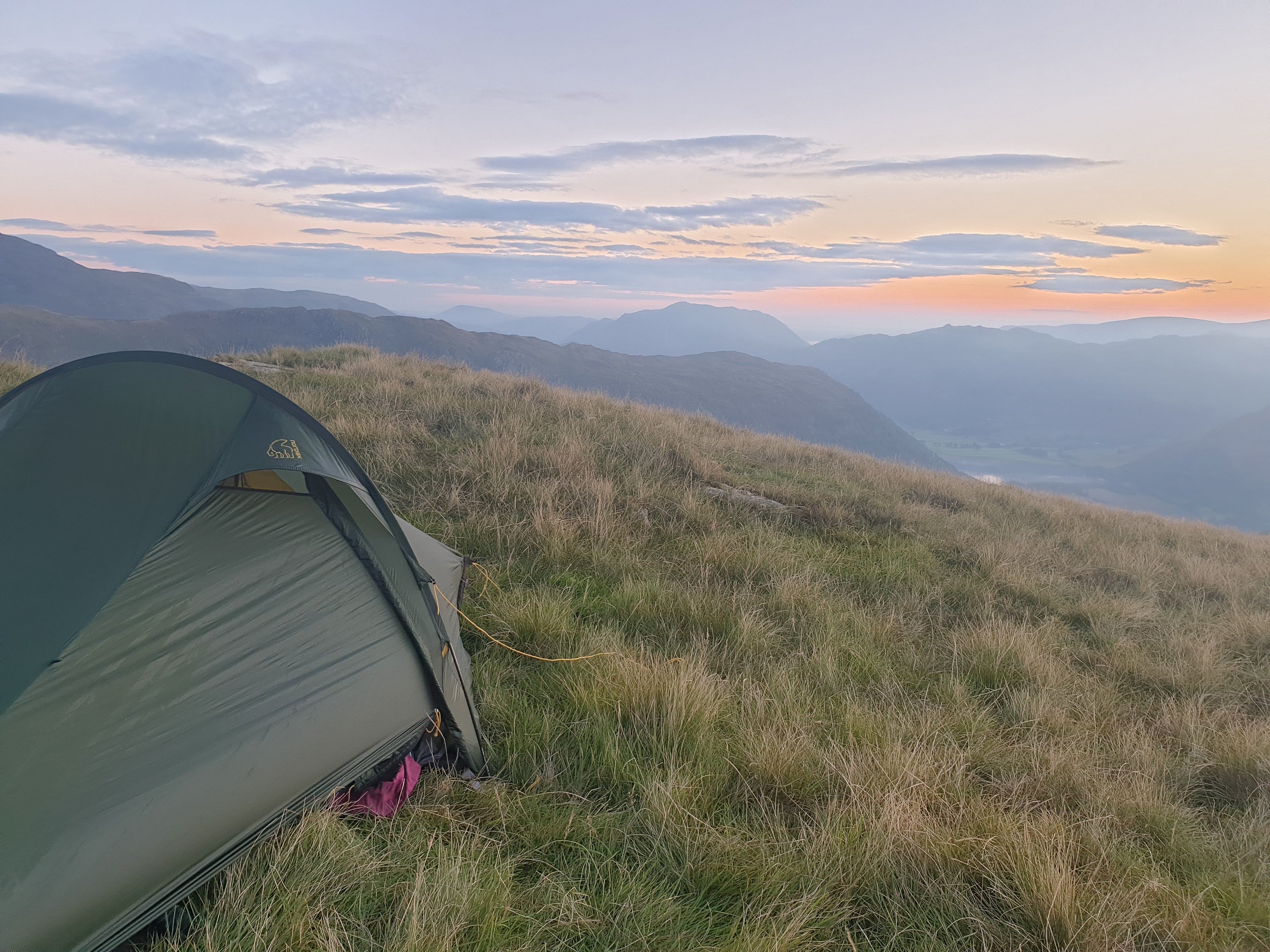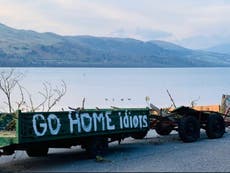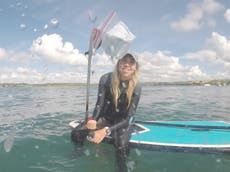Was ‘fly camping’ the big problem it seemed? I hiked 530km to find out
A boom in illegal camping this summer blighted the Lake District with discarded tents, human waste and piles of litter. Record-breaking hiker James Forrest reflects on this camping conundrum

Empty cans of Carling and stained toilet tissues were strewn across the grass. This quiet patch of Lake District countryside, next to Yew Tree Tarn and nestled below the rugged hump of Holme Fell, looked like the aftermath of a hedonistic rave. A humongous family-sized tent, two deckchairs and varied camping accessories were seemingly abandoned, as if dumped without a moment’s thought for the consequences. The ground was blackened, scorched by last night’s fire, and discarded disposable barbecues glistened with the grease of burger fat. No dancing daffodils, though, as Wordsworth famously witnessed – instead it was crisp packets and chocolate bar wrappers that fluttered gently in the breeze.
It was a sad sight – and something I’d been expecting. Recent media reports told of hordes of illegal and irresponsible campers wrecking Britain’s beauty spots with a tsunami of human waste, litter, campfires and discarded equipment. So-called “fly camping”, or “dirty camping”, was apparently out of control, fuelled by a lethal cocktail of factors: sunny weather, campsite closures, foreign holiday cancellations, the easing of lockdown restrictions and – in the absence of pubs and nightclubs – a pent-up desire to let loose. But were these ecological vandals and narcissistic litter louts really running rampage across our green and pleasant land, or was it all media hype?
I was in the Lake District on my own post-lockdown splurge of energy, in a bid to quench my wanderlust after months of cabin fever and cancelled adventures. My self-chosen mission was to climb all 214 Wainwrights – the peaks listed in Alfred Wainwright’s iconic series of pictorial guidebooks – in the fastest ever self-supported round. To make it, I’d have to walk 530 kilometres, ascend 36,000 metres (the equivalent of four Everests) and wild camp in the fells for 14 consecutive nights. But I had a subsidiary purpose too, a spot of unscientific but nonetheless intriguing research. Would the fly camping chaos ruin my adventure, or could I still enjoy the tranquillity of the Lakeland fells unperturbed by the unruly mob?
It was day seven of my expedition when I turned a corner and stumbled across the devastation at Yew Tree Tarn. I was shocked and upset, but it wasn’t representative of my Lakeland journey so far. In fact, it was the first sign of anything close to anti-social behaviour I’d witnessed. I’d seen more Herdwick sheep than people in the previous week. I’d hiked for hours and hours over quiet ridges and remote summits, enjoying the Lakeland fells all to myself. A real sense of solitude and isolation had washed over me – and, particularly at night, alone in my tent, I’d felt very far away from any human interference at all. But perhaps I was looking for trouble in all the wrong places.
By its very definition, fly camping – illegally pitching up on private land without the landowner’s permission, often close to roads or lakes – is most prevalent at tourist hotspots. While I was alone up some obscure, seldom-visited fell, the Lake District’s lakeshores and valleys were by all accounts overwhelmed. In Buttermere, 118 illegally parked campervans were recorded in one night, while in Borrowdale “Magaluf-style” revellers were accused of drunken antics, littering and all-round rowdiness. The National Trust reported its Lake District rangers were spending a fifth of their time clearing away litter and abandoned equipment, rather than on conservation work, and the Lake District National Park Authority was forced to launch a crackdown in partnership with the police, with 200 illegal campers caught in the act in one evening alone.
“How bad is the fly camping really?” I asked Steve, manager at Wasdale Hall YHA, a few days earlier, as I picked up a box of food supplies I’d previously stashed in the hostel’s wood store. “Total mayhem – I’ve never seen Wastwater so busy”, he replied. “The police and National Trust rangers are doing their level best, but we’re fighting against the tide. The influx of people has been phenomenal.” I almost began to feel guilty about my own Lakeland adventure. Any visit to a landscape, no matter how lightly you tread and responsibly you travel, has an impact – path erosion, trampling of vegetation, road congestion and pressure on local facilities. Was I contributing to the overcrowding of Wastwater, or did my self-approved ethical approach justify my presence here? I took figurative refuge behind the label of wild camper, rather than fly camper, and hoped this rationalisation would prove not to be mere self-assertive semantics.
There is, in truth, a big difference between fly camping and wild camping. Fly camping is unsubtle and obnoxious. It is brazenly camping close to roads, lakeshores, farms and villages, without permission and without consideration for the negative consequences on both nature and local communities. But wild camping is the opposite: it is responsible, inconspicuous and proportionate, and adheres to a clearly-defined code of ethics and conduct.
Wild camping is sleeping in the great outdoors, but not in an official campsite. You must pitch up late, de-camp early and always leave no trace. This means not lighting fires, carrying away all litter, burying human waste, performing toilet duties away from water sources and taking all possible steps to minimise your impact on the environment. You should always camp on open access land, above the highest fell wall and well away from hamlets or farms, and groups should be small and stay for one night only.
There is a huge difference between responsible, zero-impact wild camping away from the road and the destructive behaviour we’ve been seeing on the news, but the truth is that there are shades of grey, and both activities occupy the same fundamental spectrum
Follow these common sense rules and, far from spoiling the fun, the back-to-basics experience is amplified tenfold. Wild camping is a magical pursuit – an easy, inexpensive activity that will revive your verve for life and open your eyes once more to the wonders of the world. It is escapism in its purest form; it is losing yourself in nature; it is feeling vulnerable and exposed – and surviving; it is returning to a primal simplicity; it is getting far away from roads, cities, shops and mobile phone reception; it is resetting your equilibrium; and it is good, old-fashioned adventurous fun.
This is exactly what I’d experienced on my expedition so far. The hiking was arduous, doing daily battle with brutal ascents, knee-crushing descents and ankle-jarring terrain. Every day involved a 12 to 13 hour shift, walking at least 35 kilometres and climbing 2,500 metres while carrying everything I needed in my 10kg backpack. But get it done and I was rewarded with the spiritual joys of a night under the stars. Wild camping was the calming antidote to the fast-paced intensity of hardcore hiking – and it served up the most uplifting moment of my challenge.
By the time I arrived at Holme Fell on the evening of day six, I was feeling desperately low. Several thrashings from the fearsome Cumbrian weather over the previous 48 hours had left me exhausted, miserable and bereft of any fight. Incessant torrential rain and raging winds had eroded my spirit. I was close to the brink, blinded by self-doubt and tortured by the tantalising thoughts of how easy it would be to give up. But then the sun came out, as I pitched my tent close to Holme Fell’s knobbly summit, to the north of Coniston. I sat in the porch, sipping on a hot chocolate, and watched the sky morph into blending hues of pink, orange and red above the jagged profile of the Langdale Pikes. My anxieties and fears of failure simply floated away. Wild camping had restored my mood – and I felt a renewed determination to see my epic quest through to the end.
Technically speaking, my night on Holme Fell was not legal. Wild camping is illegal in the UK without the landowner’s permission (which I didn’t have), except in places such as Dartmoor and Scotland, where local rules permit overnight camping. But in the Lake District, and other national parks across Britain, there is a long and rich tradition of wild camping, and sleeping high in the fells has been unofficially tolerated for decades. Millican Dalton, the self-styled “professor of adventure” and pioneer of adventure tourism in the Lakes, wild camped here in the 1920s; and, ever since, so have thousands of other wild camping enthusiasts, with the trend seemingly in an upward trajectory.
But how black and white is the moral divide? Wild camping good, fly camping bad seems overly-simplistic. Clearly the misdemeanours of a small and reprehensible minority are inexcusable, their actions nothing short of criminal. No shades of grey there. Enforcement and hefty fines are needed to combat these yobs. Soft-touch finger-wagging or educational campaigns won’t cut it. In August staff from the Friends of the Lake District charity discovered an abandoned camp on a small island at Thirlmere, strewn with discarded tents, chairs, cooking pans and even dead rats, like some sort of dystopian Lord of the Flies scene. It’s hard to believe that a stern word and some educational advice from the charity workers would’ve convinced the culprits to change their ways.
In an increasingly urbanised and tech-centric country, how do we ensure our children grow up with greater access to and reverence for the countryside? It’s a tough ask
At the other end of the spectrum to these headline-grabbing cases of appalling fly camping are the purist wild campers. They follow leave no trace rules to the letter, and pride themselves on the most ethical and responsible of approaches. Rightfully, they are incandescent at the thought of their covert hobby being tarred – in the eyes of the wider public – by the same brush as fly camping. But, in some cases, this leads to an undercurrent of snobbery, with furious criticism launched at anyone whose approach differs from their own. As Alex Roddie, a long-distance walker and outdoor writer, puts it: “Instead of hostility and finger-pointing, we need empathy, openness and education.” Or, in other words, the virtuous loudly naming and shaming others is more likely to meet a defensive and resistant attitude, rather than inspire real change.
Roddie adds: “There is a huge difference between responsible, zero-impact wild camping away from the road and the destructive behaviour we’ve been seeing on the news, but the truth is that there are shades of grey, and both activities occupy the same fundamental spectrum.” The middle ground is the trickier to analyse or police, because the line in the sand is faint. If a novice wild camper makes a few rookie errors on their first night in the fells – performing toilet duties in a hurried flash of embarrassment, rather than responsibly – is that unforgivable or merely part of the learning process? Or if a wild camper, faced with stormy weather, chooses to camp in a valley rather than high in the fells, is that inexcusable or understandable? Such actions are well-meaning – and far removed from reckless fly camping – but they still contribute to the wider problem. People in the middle ground are not beyond reproach.
If every camper made small tweaks to their behaviour, things would improve. But many believe broader changes are needed. In part this could be practical – more bins, toilets, signage and countryside rangers for our beauty spots would make a difference. Yet deeper societal changes are required too. “We need long-term fundamental reforms in our relationship with nature, as a society,” explains Roddie. In Norway respect for friluftsliv (open air living) is part of the national psyche. But in an increasingly urbanised and tech-centric country, how do we ensure our children grow up with greater access to and reverence for the countryside? It’s a tough ask.
Others are more pragmatic and hopeful that problems will desist once the Covid-19 crisis is over. Chris Townsend, an author and Britain’s most experienced wild camper, says: “I doubt much can be done about this in the short term. Hopefully as more facilities open the problem will decline.” The logic is that – when pubs and bars and Magaluf are fully reopened – the litter louts won’t return to the countryside, ensuring their impromptu fly camping parties are a thing of the past. There is an interesting psychological aspect too. It is thought that the uncertainty and upheaval of the pandemic pushed people into an all-or-nothing mentality, sparking extremes of behaviour like those seen in the countryside. With the world back to normal and people less stressed, such extremes should – in theory at least – abate.
As my own adventure progressed, I didn’t witness any further scenes like those I’d seen at Yew Tree Tarn, or read about in the news. I met other wild campers, but they were always friendly, considerate and – from what I could see – behaving impeccably. Fly camping was far from my mind. It wasn’t blighting the landscape or ruining my experience. Instead, when the rain ceased and the sun appeared, the adventure was everything I wanted it to be. I wiggled an intricate, complex route linking all 214 Wainwright fells, tramping to every hidden nook and cranny of the Lake District – that heavenly place of wobbly dry stone walls, sweeping ridges, craggy buttresses, towering summits, tumbling streams and glistening lakes.
Every day I hiked, every night I camped, and in-between the mountains gave me what I needed. At home I felt agitated and frustrated, but out walking I was happy and free. It was as if I was tapping into something intrinsic, like an ancestral yearning to be connected to the landscape and nature. I found the process of putting one foot in front of the other therapeutic. It cleared my head, helped me destress and put life’s little problems into perspective.
From iconic giants like Scafell Pike, Blencathra and Helvellyn to dinky humps such as Helm Crag, Latrigg and Castle Crag, walking the Wainwrights gave me an intimate interaction with the Lake District. I ambled lonely valleys, followed dancing becks, glided over sun-drenched ridges and posed triumphantly on craggy summits. It was a memory-forging, happiness-inducing journey – and slowly but surely I neared my final summit.
I walked the final few metres, placed my hands atop Cat Bells’ trig pillar and smiled. I’d made it. Mission accomplished. All 214 Wainwrights climbed in 14 days and 11 hours – the fastest ever solo and self-supported round. I felt proud. I’d discovered depths of resilience, positivity and determination I didn’t even know I possessed, and I’d overcome all manner of self-doubts and personal demons.
I took a quiet moment of reflection and thought about my favourite quote from Alfred Wainwright: “I was to find… a spiritual and physical satisfaction in climbing mountains – and a tranquil mind upon reaching their summits, as though I had escaped from the disappointments and unkindnesses of life and emerged above them into a new world, a better world.” In 2020 that world might have been tainted by the ills of reckless, disdainful fly campers, but – from my experience – they hadn’t irrefutably ruined it. It was still a better world.
James Forrest is the author of ‘Mountain Man: 446 mountains. Six months. One record-breaking adventure’, published by Bloomsbury




Join our commenting forum
Join thought-provoking conversations, follow other Independent readers and see their replies
Comments